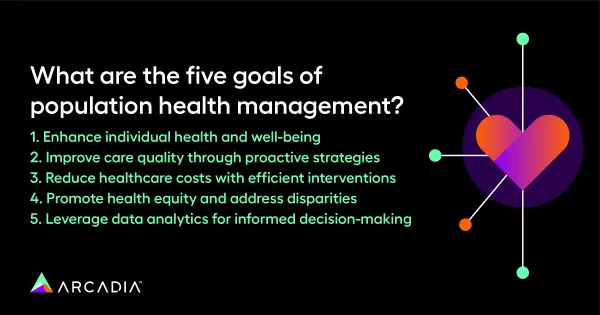The five goals of population health management
In today's healthcare landscape, leaders are increasingly focused on improving health outcomes while effectively managing costs. To address these complexities, population health management (PHM) has emerged as a proactive approach that aims to optimize the health outcomes of a defined population.
In this article, we explore the goals of PHM and its transformative impact on individuals, care quality, and the healthcare industry.

What are the five goals of population health management?
1. Enhance individual health and well-being
A primary goal of population health management is to improve the health and well-being of individuals within a specific population. This objective has a strong emphasis on preventive care, early intervention, and effective chronic disease management.
By leveraging advanced analytics, comprehensive care coordination, and patient engagement tools, PHM empowers healthcare providers to deliver personalized care that caters to the unique needs of individuals. This type of approach results in improved health outcomes and heightened patient satisfaction.
2. Improve care quality through proactive strategies
PHM aims to enhance the overall quality of care by shifting from reactive, episodic care to proactive, preventive care. By leveraging data-driven insights, healthcare technology platforms support healthcare providers in identifying gaps in care, implementing evidence-based practices, and developing targeted interventions.
This proactive approach helps prevent hospital readmissions, reduce complications, and ensure patients receive the most appropriate and effective treatments, which ultimately fosters higher quality care.
3. Reduce healthcare costs with efficient interventions
Efficiency and cost reduction are critical goals in population health management. By utilizing sophisticated data analytics, healthcare technology platforms enable providers to identify high-risk individuals, implement targeted interventions, and streamline care delivery processes.
This proactive and cost-effective approach helps prevent costly hospitalizations, emergency room visits, and unnecessary procedures, leading to substantial savings for healthcare organizations and improved financial sustainability.
4. Promote health equity and address disparities
Another essential objective of PHM is to promote health equity and address disparities within a population. Leveraging advanced data analytics, healthcare technology platforms enable providers to identify social determinants of health and target interventions to specific at-risk groups.
This goal ensures that individuals from all socioeconomic backgrounds, ethnicities, and geographic locations have equal access to quality care and resources, fostering improved health outcomes and reducing disparities.
5. Leverage data analytics for informed decision-making
Population health management relies on robust data analytics and cutting-edge technology to drive informed decision-making. Through aggregating and analyzing population health data, healthcare technology companies provide valuable insights into health trends, risk factors, and care gaps to healthcare organizations.
These insights empower strategic planning, resource allocation, and evidence-based interventions, facilitating more effective population health management and optimizing healthcare delivery.
The power of population health management and data analytics
At the core of effective population health management lies the integration of advanced data analytics and healthcare technology platforms. By harnessing the power of data, healthcare organizations can gain a comprehensive understanding of their population's health needs, identify trends, predict risk factors, and monitor the effectiveness of interventions.
This collaboration between population health management and data analytics enables healthcare leaders to make data-driven decisions that improve outcomes, reduce costs, and enhance patient care across the continuum.
Drive lasting change with population health management
Population health management, powered by healthcare technology, is revolutionizing healthcare delivery by focusing on the well-being of entire populations. By embracing the goals of enhanced individual health, improved care quality, reduced costs, health equity, and data analytics, healthcare leaders can drive positive change within their organizations.
Are you ready to revolutionize healthcare delivery within your organization? Learn more about our comprehensive population health management solutions and take the first step toward driving lasting change.
